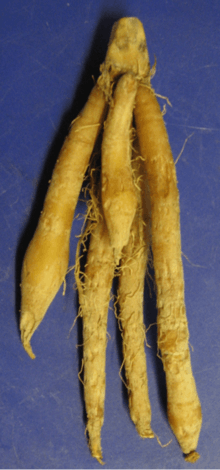Boesenbergia rotunda
| Boesenbergia rotunda | |
|---|---|
 | |
| Scientific classification | |
| Kingdom: | Plantae |
| Clade: | Angiosperms |
| Clade: | Monocots |
| Clade: | Commelinids |
| Order: | Zingiberales |
| Family: | Zingiberaceae |
| Genus: | Boesenbergia |
| Species: | B. rotunda |
| Binomial name | |
| Boesenbergia rotunda | |
| Synonyms[1] | |
| |
Boesenbergia rotunda, commonly known as Chinese keys,[2] fingerroot, lesser galangal or Chinese ginger, is a medicinal and culinary herb from China and Southeast Asia. In English, the root has traditionally been called fingerroot, because the shape of the rhizome resembles that of fingers growing out of a center piece.
Fingerroot is a kind of ginger (Zingiberaceae). It is annual crops and indigenous to southern Yunnan Province, China, to west Malaysia. Tropical rain forest is where this fingerroot grows.[3] It has underground trunk, which is called rhizomes. Rhizomes underground branch goes out into many bunches same as ginger, galangal and turmeric. They will accumulate food. The middle part is more swollen than the head and bottom part. The inner part has a variety of color according to the type of fingerroot and aroma. The above ground part is composed of leaf stalk that has a leaf sheath covering it. The leaf sheaths are red, the blades are oval shape and the apex of leaves are sharp.[4] Chinese ginger is herbaceous plant with a height of 2–3 feet. The leaf is about 50 cm. long and 12 cm. wide.[3] The middle of the petioles are deep groove. The bouquet is inserted between the leaf sheaths at the bottom of the trunk. The petals are white or light pink. Flowers bloom one at a time. It looks like a bag. The fruit is dry when it is very old.[4]
Common names
- Cambodian:k'cheay (Khmer: ខ្ជាយ)
- Indonesian: temu kunci
- Sinhalese: haran kaha (හරං කහ)
- Thai: krachai (กระชาย)
- Vietnamese: bông nga truật
Uses
Fingerroot is known as temu kunci in Indonesian. It is widely used in Javanese cuisine in Indonesia.
In Thai cooking it is called krachai (Thai: กระชาย; pronounced [krà.tɕʰāːj]) and is an ingredient of dishes such as kaeng tai pla. It is used in some kroeung pastes of Cambodian cuisine and is known as k'cheay (Khmer: ខ្ជាយ). In the west it is usually found pickled or frozen. It is sometimes confused with Alpinia officinarum, another plant in the family Zingiberaceae which is also known as lesser galangal. In Meitei, it is called Yai-macha.
Rhizomes of Krachai can be used as medicine to heal mouth illness such as oral eczema, mouth ulcer and dry mouth. It can cure diuresis, dysentery and abdominal pain. From experiment with alcohol extracts and chloroform. It resists effectively the antifungal that causes dermatitis and mouth disease.[4]
References
- ↑ "The Plant List: A Working List of All Plant Species". Retrieved 25 January 2014.
- ↑ "Boesenbergia rotunda". Germplasm Resources Information Network (GRIN). Agricultural Research Service (ARS), United States Department of Agriculture (USDA). Retrieved 12 December 2017.
- 1 2 "Boesenbergia rotunda (L.) Mansf. | Plants of the World Online | Kew Science". powo.science.kew.org. Retrieved 15 October 2017.
- 1 2 3 "กระชาย สมุนไพรลดน้ำหนัก ชะลอความชรา บำรุงร่างกายให้ฟิตปั๋ง". kapook.com. Retrieved 15 October 2017.
External links